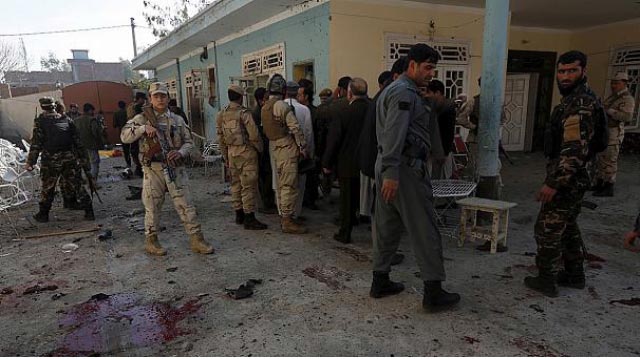Every gun that is made, every warship launched, every rocket fired signifies in the final sense, a theft from those who hunger and are not fed, those who are cold and are not clothed. This world in arms is not spending money alone. It is spending the sweat of its laborers, the genius of its scientists, the hopes of its children. This is not a way of life at all in any true sense. Under the clouds of war, it is humanity hanging on a cross of iron.”
During the Taliban’s regime, we witnessed the human bodies torn to bloody shreds with fighters’ shells, thunder of the guns with the shrieks of the wounded populace writhing in pain, waste of the humble homes with hurricane fire, the hearts of the unoffending widows wrung with unavailing grief, the women turned out roofless, along with their children, wandering unfriended the wastes of the desolated land in rags and hunger and thirst, sports of the sun, flames of summer and the icy winds of winter, broken in spirit, worn with travail, imploring God for the refuge of the grave and denied it.
The Taliban movement grew from the Afghan orphans or refugee children who attended madrasahs. Their rapid rise to power must be seen in the context of chaos and civil war in Afghanistan, with warlords running amok and complete breakdown of law and order. The small band of Taliban was first led by Mullah Umar against a local warlord in Spin-Boldak and led to the capture of Kandahar in November 1994, with scarcely a shot being fired. The subsequent rise and spread of the Taliban in Afghanistan surprised most observers, and was generally welcomed by a war weary and destitute population.
To the development agencies the Taliban government brought some respite from incessant conflict. However, their tribal and medieval interpretation of religion led to the imposition of draconian policies restricting the rights of women and ethnic minorities. Their edicts on female education, dress code, and employment were largely based on an extremely orthodox misinterpretation of religious law, and a source of great distress to many in the Islamic world. In an ironic twist of fate, the Taliban era also saw Afghanistan suffer from one of the worst droughts of this century, which virtually wiped out many sectors of a largely agrarian economy. Despite plentiful evidence of the impact of economic sanctions on the most vulnerable in society, especially children, Afghanistan was progressively deprived of assistance to the extent that even humanitarian agencies found it difficult to operate.
Notwithstanding the hardship due to drought and sanctions, the Taliban policies brought disproportionate suffering and impoverishment to war widows and families in Afghanistan. Food shortages and malnutrition had their biggest impact on Afghan female children. Less obvious are the psychological trauma and mental stress experienced by Afghan women and children and the impact of continued illegal conscription of child soldiers by all warring factions.
The lasting impact of war on the psychological state of women and children is well described. Many have post-traumatic stress as a consequence of witnessing or experiencing parental loss in war. Political repression and state terror have also been shown to result in significant psychological sequelae.
A landmark survey conducted by UNICEF, few years ago, on the effect of war on children aged 8-18 years in Kabul indicated that 41% had lost one or more parents because of the conflict, and over half had witnessed torture or violent death. Over 90% of the children interviewed expressed the fear of dying in the conflict. A particularly gruesome practice of encouraging children to witness public amputations and executions has an enormous impact on impressionable minds. Over 80% of the children interviewed felt they could not cope with events and that life was not worth living.
While such events can lead to considerable psychological trauma and distress, they may also inure a young mind to violence. The average Taliban and Northern Alliance soldiers are a product of the same cycle of violence and social upheaval experienced from early childhood. Ignorance, isolation, and a daily ritual of violence greatly temper their vision of the world.
Morally, the experience of indifference from the surrounding world, or, worse still, malevolence may cause children to suffer loss of meaning in their construction of themselves in their world. They may have to change their moral structure and lie, steal, and sell sex to survive. They may have their moral structure forcibly dismantled and replaced in training to kill as part of a military force.
It is self-explanatory that if warring factions do not sit around the negotiating table, violence and bloodshed will continue unabated which will take toll of combatants and non-combatants. It is feared that the Taliban and the self-styled Islamic State (IS) group will intensify their attacks in case of not reaching an amicable agreement. With the Taliban’s last year spring offensive, hundreds of civilians lost their lives. The fact is that people bear the brunt of terror and militancy and it is no more acceptable. It is the Quadrilateral Coordination Group (QCG) to pressurize the Taliban to resume peace talk or the government will have to deal them militarily. In a nutshell, the government is supposed to “form a civil society void of oppression, atrocity, discrimination as well as violence, based on rule of law, social justice, protecting integrity and human rights, and attaining peoples’ freedoms and fundamental rights, strengthen political, social, economic as well as defense institutions; attain a prosperous life and sound living environment for all inhabitants of this land”.
Home » Opinion » Stop Violence and Bloodshed
Stop Violence and Bloodshed
| Hujjatullah Zia

